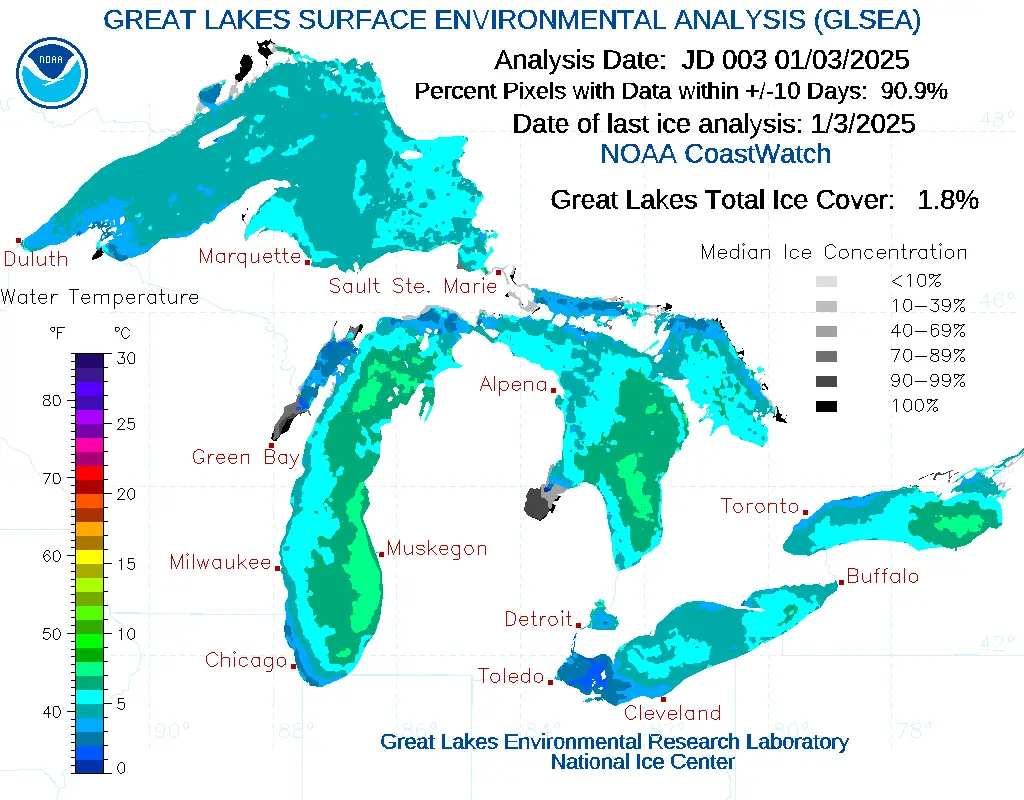Bitter cold temperatures grip the upper midwest, accelerating Great Lakes ice growth and impacting navigation and winter activities
Arctic Blast Drives Ice Expansion Across Great Lakes
The Great Lakes region is witnessing rapid ice formation as a powerful Arctic airmass moves through, the National Weather Service (NWS) reported Friday. Temperatures are plunging well below freezing, creating ideal conditions for ice growth on major water bodies, including Lake Superior, Lake Michigan, and Lake Erie. This development marks a significant change from previous milder conditions and poses challenges for local communities, shipping, and recreational activities.
The NWS indicated that ice is forming in critical areas such as Green Bay, Saginaw Bay, and around Sault Ste. Marie, with notable ice expansion expected near the Apostle Islands and the southern shores of Lake Superior.
Temperature Drop Fuels Ice Growth

Weather forecasts show sustained below-average temperatures for the next five days, with highs remaining in the single digits across northern cities like Duluth, Minnesota, and Marquette, Michigan. The arrival of Arctic air this weekend will likely accelerate ice coverage, especially in previously open water areas.
“Conditions for ice growth are optimal,” said the NWS report. “Shore ice is forming along the western basin of Lake Erie and southern Green Bay, with medium confidence for further development in these areas.”
Colder conditions are not only aiding the formation of new ice but also thickening existing ice layers, particularly along the shores and in sheltered bays.
Shipping and Navigation Face Challenges
The increasing ice coverage presents obstacles for maritime traffic. Commercial vessels navigating the Great Lakes will encounter ice in key channels such as the St. Marys River and Lake Nicolet. Icebreaker services may soon be necessary to maintain critical trade routes.
The shipping industry is a vital economic engine for the region, transporting goods like grain, coal, and iron ore. However, thickening ice can impede operations, delay shipments, and increase costs.
The U.S. Coast Guard routinely monitors ice conditions and assists in clearing navigational paths during winter months. As ice grows, updated advisories and restrictions are expected to follow.
Impact on Communities and Recreational Activities
For local communities, ice formation brings mixed effects. It signals the beginning of popular winter activities like ice fishing, skating, and snowmobiling. However, early-season ice can be unpredictable and pose significant safety risks.
Authorities urge residents to exercise caution. “Ice may not be as thick as it appears,” warns the NWS. “Always test conditions before venturing onto frozen surfaces.”
Communities near Saginaw Bay and Chequamegon Bay, which are seeing notable ice buildup, are particularly affected. Ice conditions in these areas are often monitored closely due to their popularity among anglers and winter sports enthusiasts.
Looking Ahead: Arctic Air to Persist
After a brief moderation in temperatures early next week, another surge of Arctic air is expected, extending the frigid conditions into mid-January. This pattern is likely to sustain the rapid pace of ice growth across the Great Lakes.
Experts at the Great Lakes Environmental Research Laboratory (GLERL) are closely monitoring water temperatures and ice development. The lab’s data shows significant deviations from normal freezing degree day accumulations, highlighting how this cold wave is reshaping the region’s ice profile.
Marquette, for example, recorded 345 freezing degree days compared to a historical norm of 464. This lag in ice formation is now being rapidly corrected by the intense cold.
Related Links and Updates
- Michigan Features: Discover the hidden gems and unique events across Michigan.
- Weird Political News: A sarcastic look at political happenings in the U.S.
- Michigan News: Stay updated with events and stories from Michigan’s Upper Thumb.
Your Turn – Like This, or Hate it – We Want To Hear From You
Please offer an insightful and thoughtful comment. Idiotic, profane, or threatening comments are removed. Consider sharing this story. Follow us to have other feature stories fill up your Newsbreak feed from ThumbWind Publications.



